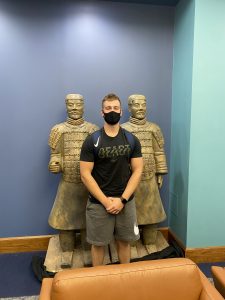Today I had the honor of getting my picture taken with the two replicas of the terracotta warriors that were excavated in China. The replicas had been on display at the Children’s Museum in Indianapolis, but were purchased and donated to us here at Butler University. They can be found in Jordan Hall 109.
In 1974, farmers outside of Xi’an, Shaanxi, China were digging a well when they came across a large clay figure. Since then, archaeologists have discovered thousands of clay figures that depict soldiers, chariots, and horses that were part of Qin Shi Huang’s armies (Qin Shi Huang is proclaimed to be the first Emperor of China). The purpose of the clay sculptures is to bury them next to the emperor to protect him in the afterlife, so it is no coincidence that Qin Shi Huang’s unexcavated tomb lies nearby. It is believed that the statues are different heights based on their rank/role, so the tallest of the figures are the generals. Non-military figures were also found, including acrobats and musicians, likely to provide the emperor entertainment in the afterlife.
